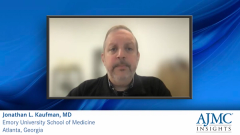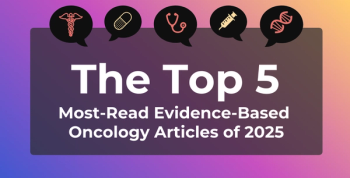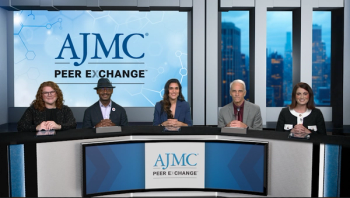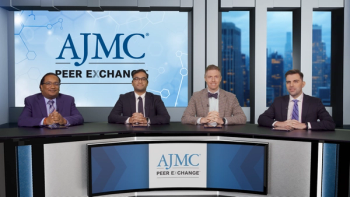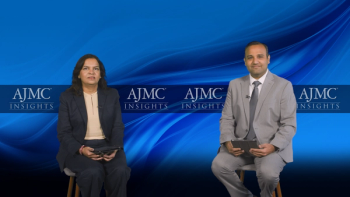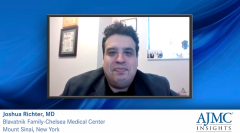
Discussing The Future of the RRMM Treatment Landscape
Drs Richter and Kaufman conclude by discussing future promising developments in RRMM therapy.
Episodes in this series

Joshua Richter, MD: To me, the biggest thing that I am looking forward to in the next few years is the evolution of bispecific antibodies. Everyone has been interested in CAR T therapy, and CAR T therapies are wonderful. However, we must recognize that 60%–80% of myeloma in the United States is treated in the community, and CAR T will never be a community option. We must think broadly about what’s going to provide the most good for the largest amount of patients, and that’s likely going to be with off-the-shelf bispecific antibody products. To me, some of the most exciting ones are what we call the non-BCMA bispecifics. BCMA as a target has been exploited in the antibody drug conjugates like belantamab, CAR T therapies like Abecma and Carvykti, and then some bispecific antibodies like Teclistamab, tineobio, Regeneron 5458, and elranatamab. However, we recognize that there are about to be a number of anti-BCMA therapies, and we are already looking to what’s beyond that. Looking beyond that, in terms of target, there are 2 big leaders in the realm of non-BCMA bispecifics. There is talquetamab, which targets something called GPRC5D, and cevostamab, which targets FcRH5. These 2 drugs are coming along, with talquetamab likely to be FDA approved by 2023 and cevostamab hopefully to be approved by 2024. These therapies are going to be the next generation, especially as BCMA-targeted agents move to earlier lines [in therapy]. We need to think about immunotherapy for the BCMA-refractory patients, and talquetamab and cevostamab are poised to take over that space in the next few years. There are great options, and what I want to say to people right now is that we cure a small number of patients accidentally, but over the next 5– 10 years, we are going to cure more patients intentionally and change this from a generally incurable disease to a potentially more broadly curable process.
The optimal thing that we have seen is the involvement of myeloma centers. There are great myeloma centers all over the country and world; even if the patient is being treated locally, we know that interaction, even with procedure such as telemedicine, may greatly improve outcomes for patients, and there are studies proving this. If you are managing a myeloma patient or know one and they are being treated locally, then they can continue to be treated locally, but consider involving one of the myeloma centers to provide some of those nitty-gritty details that may optimize outcomes.
Jonathan L. Kaufman, MD: The most promising things that we have on the horizon for patients with relapsed and refractory myeloma continues to be targeting the immune system and using drugs that either directly use the immune system or pull in the immune system, CAR T-cell therapies and the bispecific antibody therapies. Bispecific antibody therapies, while not approved yet, will likely see approval in the year. With the first several doses, there is a major toxicity called CRS—which we know about with CAR T cells, cytokine release syndrome—and it’s very important that we come up with a funding model for patients to be treated in the hospital or accept that the patient will be treated in the clinic and then transferred to the hospital. That requires a payer to really understand the medication, the potential adverse events, and that the care of a patient getting a bispecific will likely occur both on the outpatient side as a treatment and on the inpatient side as an observation. The other type of therapy that is still growing in myeloma but will likely grow further is specifically targeting the underlying biology of the myeloma. An example I will give is those patients with 11;14 myeloma. Those patients with translocation 11;14 inside their myeloma cell are much more likely to benefit from venetoclax, and venetoclax is not a drug that is currently approved for use in myeloma but is very effective in this subset of patients. These patients represent 15%–20% [of myeloma patients], and similar to what we have seen with other diseases based on the underlying biology within a myeloma cell is taking drugs that are approved for other diseases and bringing that into specific diseases in myeloma. Another example of this would be the RAS pathway inhibitors, the BRAF inhibitors, and things that can sometimes be effective in a fraction of myeloma. If a patient population harbors this mutation but is only 5% of myeloma [patients], we are never going to be able to do a large, randomized study to demonstrate that efficacy. We are going to have to rely on smaller data to support the use of these targeted therapies.
To summarize, the one thing that I would tell payers is that in myeloma, these patients live a long time, but ultimately, you are not cured from the disease and do require a lifetime of effective therapies. These therapies have dramatically improved both the quality and length of life of patients with myeloma.
This transcript has been edited for clarity.
Newsletter
Stay ahead of policy, cost, and value—subscribe to AJMC for expert insights at the intersection of clinical care and health economics.

